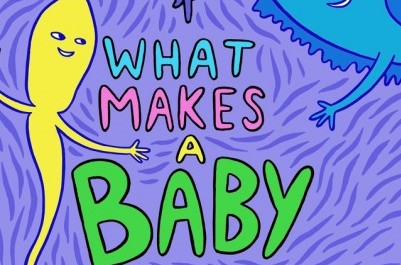What Makes a Baby is a book for every kind of family and every kind of kid. Ever wish you could explain the concepts of fertility, baby making, and love in a less gender specific, stereotypical way? Well Cory Silverberg has saved the day. We are mad for this children’s picture book about where babies come from that is written and illustrated to include all kinds of kids, adults, and families.
Geared to readers from pre-school to about 8 years old, it teaches curious kids about conception, gestation, and birth in a way that works regardless of whether or not the kid in question was adopted, conceived using reproductive technologies at home or in a clinic, through surrogacy, or the old fashioned way (you know, with two people and some sexual intercourse), and regardless of how many people were involved, their orientation, gender and other identity, or family composition.
Just as important, the story doesn’t gender people or body parts, so most parents and families will find that it leaves room for them to educate their child without having to erase their own experience.
Watch:
What Makes a Baby Book Trailer from Cory Silverberg on Vimeo.
Our kids are mad for this book and now understand that some bodies have ovaries and others have sperm. It’s a really fun, matter of fact, modern take on how we got here, and we highly recommend it for every little ‘un. We were fascinated by what drew Silverberg to write this book. Raised by a children’s librarian and a sex therapist, Cory grew up to be a certified sexuality educator and writer.
In some ways it’s a really radical book. So we asked him for more on what drew him to this topic;

Silverberg said;
I wrote What Makes a Baby partly because I disagree with the facts as they are usually presented. The“facts of life” usually mean the facts of only some people’s lives, and really they end up meaning the facts of some idealized life that no one actually lives. So I wanted to write a book for kids about where they came from that would more closely represent the actual story. I’d like to think this is the book Mrs. G would write.
I wanted to write a book that both adults and kids would actually want to read. So much sex education is well meaning but has a feel of required reading to it. Parents often approach this topic with anxiety and I wanted to give them something that would make them laugh and hopefully relax a bit, since young children don’t have anxiety about this topic at all. They learn it from us!
It’s a social justice approach which means, among other things, not centering one experience because it’s the most common, or easiest to explain, or simply because it’s the experience of people with the most power and privilege. In concrete terms that meant not starting with intercourse. Interestingly, once you decide to shift the center of the story (in this case from intercourse to the desire to make a baby however it’s made) a whole range of new possibilities present themselves. And so what the book does is teach the very basics about what one needs to make a baby, what all of us need to be made, and then it asks the parent or adult reader to do some of the work, filling in as much or as little detail on the unique story of that child’s conception, gestation, and birth, as they like.
A second social justice element to this book is that I don’t give all the answers. Which is appropriate. It’s not for me to say how or why every child is born. We need to give parents and caregivers flexible and fun tools so they can tell their own stories. At the same time I want to encourage us to tell children some stories about what connects us to each other.
Baby making is storytelling. When it comes to things related to our bodies and sexuality we have a tendency to think of them as somehow“natural”and fixed, more true then, say, our values or beliefs. But they aren’t. Our bodies, even at the cellular level, are influenced by our environment, our communities, our culture, and our planet. One way we compartmentalize sexuality and reproduction is by teaching our children and ourselves that it’s something different from the rest of life. I don’t see it that way. I want kids to grow up knowing that the world is full of stories, and they are full of stories, and they have a right to hear stories that reflect their experience and write their own stories, not just about how they feel, but about who they are.



